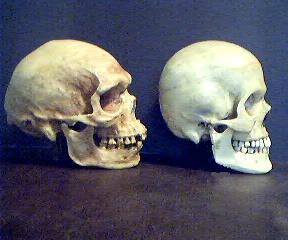One may surmise that, since the fossil evidence clearly implies that modern human populations are (at least partly) descended from earlier “proto-human” populations that inhabited the same areas, somebody had to address this in such a way as to preserve the orthodox view that racial differences are superficial. There are too many morphological similarities between Neanderthals and modern Europeans (which show a clear chronological transition) to be due to mere chance. The same is true of Asian populations and Asian “proto-humans”. Taken at face value, this evidence throws the whole “race is only skin deep” dogma into disarray. Wolpoff and Caspari tackle this problem creatively by claiming that all hominids, dating back to Homo erectus, are the same species: modern humans.
How do Wolpoff and Caspari define “modern human”? Well… first they start with the “precept” that all living humans are modern:
We know that in spite of its incessant use, “modern human” has proven to be an elusive and slippery term to define. There is no consensus on definitions of modernity… We don’t know how “modern human” is defined, because not only are different definitions contradictory, but when definitions of modernity have been proposed for skeletal remains, the inadvertent consequence has been that the definitions successfully excluding archaic groups also exclude some members of contemporary populations, and this, of course, will not do. We must begin with the precept that all living humans are modern! (pg. 344)
and:
This is why it has proved impossible to provide an acceptable definition of modernity. Repeated attempts at a definition based on skeletal variation have failed because when they were applied to skeletal samples, it was found they did not include all recent or living people. How could this happen? It comes back to the importance of Neandertals, because these anatomical definitions are based on the assumption Neandertals were not modern humans. Indeed, they were constructed to exclude Neandertals. However, when the definitions were applied to populations around the world, it was quickly discovered that significant numbers of Holocene and recently living Aboriginal Indigenous Australians were not “modern”. This problem, of course, is not with the Aboriginal Indigenous Australians who are each and every bit as modern as the authors of the definitions, but with the definitions themselves and their focus on Neandertals.
Here we need to ask, from a purely scientific standpoint, why is it not possible that some contemporary human populations are not entirely “modern”? After all, even according to other anthropologists, it is quite possible that a properly educated Neanderthal could read, write and otherwise function in our society. This alone does not necessarily mean that they are “modern” humans. It is even possible that aliens from outer space might be able to function in human society (perhaps even better than we do) even though they are not human at all. If we examine the overall performance of Australian aborigines in modern times, one could easily imagine Neanderthals doing at least as well. It would appear that their average I.Q. is around 60, among the lowest in the world. To be sure, the term “modern”, even in the world of anthropology, can be a very subjective one. But, if it is to have any meaning at all, let it be based on science. Not sensitivity to the feelings of “living populations”.

Yes, the major human families around the world differ in such distinct and sometimes dramatic ways that it seems preposterous that a serious taxonomist would lump all humans into one subspecies. The differences in dental structure alone is sufficient to not only define, but to identify varying racial groups. Any forensic anthropologist worth his salt can categorize the remains of a human body by race simply by looking at the teeth. I know of no other species in the world with the amount of physical variability of humans that is not divided into separate subspecies.
ReplyDeleteYour picture of an Aborigine skull next to a European skull is a great visual example of the plainly obvious morphological distinctions between the races. That picture is always a good starting point when discussing race with a race denier. I've found that nine times out of ten, most untrained people will look at those two skulls and assume that the Aborigine skull is that of an archaic human ancestor, not that of a modern living human.
[...] post: Science and sensitivity « Jewamongyou's Blog Share and [...]
ReplyDeleteThis regionalism stuff applies to cities and towns. People from different cities and towns often have different accents and are known for different mannerisms.
ReplyDelete